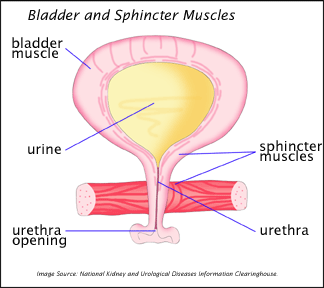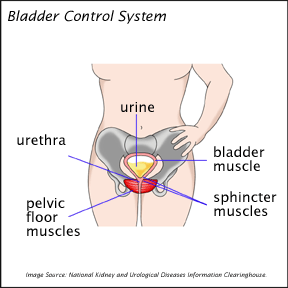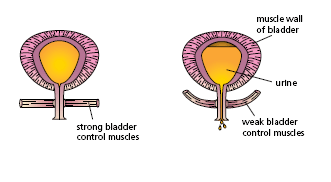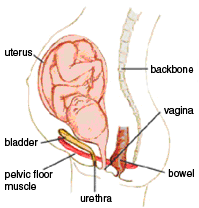
Urinary Incontinence
back to Gynecology Care
Home
- What is urinary incontinence?
- What causes urinary incontinence?
- How common is urinary incontinence?
- Does having a baby cause urinary incontinence?
- Does menopause affect urinary incontinence?
- Are there different types of urinary incontinence?
- How do I talk to my doctor about urinary incontinence?
- How do I find out if I have urinary incontinence?
- Is there anything I can do to prevent urinary incontinence?
- How is urinary incontinence treated?
What is urinary incontinence?
Urinary (YOOR-in-air-ee) incontinence (in-KAHN-tih-nens) is when urine leaks out before you can get to a bathroom. If you have urinary incontinence, you're not alone. Millions of women have this problem.

 |
What causes urinary incontinence?
There are many reasons why a woman may leak urine. Sometimes it's caused by an illness, in which case bladder control returns when the illness goes away. For example, bladder infections and infections in the vagina can cause incontinence for a short time. Being unable to have a bowel movement or taking certain medicines also may make it hard to control your bladder.
Sometimes incontinence is an ongoing problem, in which case the cause might be:
- the bladder cannot empty completely
- weakening of the muscles that help to hold or release urine
- a blocked urinary passage
- damage to the nerves that control the bladder
Sometimes, diseases such as arthritis make it hard to get to the bathroom in time and can make it even harder to control urine leakage.

How common is urinary incontinence?
More than 13 million Americans — male and female, young and old — have incontinence. Women are more likely to leak urine than men.Older women have more bladder control problems than younger women. But loss of bladder control does not have to happen as you age. If you're leaking urine, talk to your doctor about it. Your doctor can help you. For more information on talking to your doctor about urinary incontinence, see "How do I talk to my doctor about urinary incontinence?"
Does having a baby cause urinary incontinence?
Yes. It can, but don't panic.
If you lose bladder control after having a baby, the problem often
goes away by itself. Your muscles may just need time to recover. Being
pregnant also can cause leakage due to:
Being
pregnant also can cause leakage due to:
- pressure of the pregnancy on the bladder and pelvic muscles
- vaginal delivery
- episiotomy (the cut in the muscle that makes it easier for the
baby to come out)
- damage to bladder control nerves
If you still have bladder problems six weeks after having your baby, talk to your doctor. Without treatment, lost bladder control can become a long-term problem. Leaking can also result from some medical conditions, including neurologic injury, birth defects, strokes, multiple sclerosis, and physical problems associated with aging.Sometimes bladder control problems show up years after you've had your baby. Some women do not have problems until later, often in their 40's.Unborn babies push down on the bladder, urethra (tube that you urinate from) and pelvic muscles.
Does menopause affect urinary incontinence?
Yes. Some women have bladder control problems after they stop having periods (called menopause or change of life). After your periods end, your body stops making the female hormone estrogen (ES-truh-jun). Some experts think this loss of estrogen weakens the vaginal tissue.If you're leaking urine, talk to your doctor about it. Your doctor can help you. See "How Do I Talk To My Doctor About Urinary Incontinence?"
Are there different types of urinary incontinence?
Yes.
- Stress incontinence — leakage happens
with coughing, sneezing, exercising, laughing, lifting heavy things,
and other movements that put pressure on the bladder. It is the
most common type of incontinence. It can be treated and sometimes
cured.
- Urge incontinence — this is sometimes
called "overactive bladder." Leakage usually happens after a strong,
sudden urge to urinate. The sudden urge may occur when you don't
expect it, such as during sleep, after drinking water, or when
you hear running water or touch it.
- Functional incontinence — leaking because
you can't get to a toilet in time. People with this type of incontinence
may have problems thinking, moving, or speaking that keep them
from reaching a toilet. For example, a person with Alzheimer's
disease may not plan a trip to the bathroom in time to urinate.
A person in a wheelchair may be unable to get to a toilet in time.
- Overflow incontinence — leaking urine
because the bladder doesn't empty completely. Overflow incontinence
is less common in women.
- Mixed incontinence — two or more types
of incontinence together, most often stress and urge incontinence.
- Transient incontinence — leaking urine for a short time due to an illness such as a bladder infection. Leaking stops when the illness is treated.
How do I talk to my
doctor about urinary incontinence?
Most people don't want to talk
to their doctor about such a personal topic. But keep in mind that
urinary incontinence is a common medical problem. Millions of women
have the same problem, so your doctor has probably heard many stories
like yours.Even if you feel shy, it is up to you to take the first
step. Some doctors don't treat bladder control problems, so they
may not think to ask about it. Others might expect you to bring up
the subject. If your doctor doesn't treat bladder problems, ask for
help finding a doctor who does.Here are some questions to ask your
doctor:
- Could what I eat or drink cause bladder problems?
- Could my medicines (prescription or over-the-counter) cause bladder
problems?
- Could other medical conditions cause loss of bladder control?
- What are the treatments to regain bladder control? Which one
is best for me?
- What can I do about the odor and rash caused by urine?
It may help to write down when you leak urine. Be sure to note what you were doing at the time, for example, sneezing, coughing, laughing, or sleeping. Take this log with you when you visit your doctor.
back
to top
How
do I find out if I have urinary incontinence?
The first step is to
see your doctor. If your doctor doesn't treat bladder problems, ask
for help finding someone who does.Your doctor will ask you about
your symptoms and take a medical history. Your doctor will ask you:
- how often you empty your bladder
- how and when you leak urine
- how much urine you leak
- Stress test — while you cough or bear
down, the doctor watches for loss of urine.
- Urinalysis — you give a urine sample,
which is tested for signs of infection and other causes of incontinence.
- Blood test — you give a blood sample,
which is sent to a lab where it is tested for signs of other causes
of incontinence.
- Ultrasound — sound waves are used to take
a picture of the kidneys, bladder, and urethra. Your doctor will
look to see if there are any problems in these areas that could
cause incontinence.
- Cystoscopy — a thin tube with a tiny camera
is placed in the urethra to view the inside of the urethra and
bladder.
- Urodynamics — a thin tube is placed into your bladder and your bladder is filled with water. Your doctor measures the pressure in the bladder.
Your doctor may ask you to write down when you empty your bladder and how much urine you produce for a day or a week.
Is there anything I can do to prevent urinary incontinence?
Yes. Exercising your pelvic floor muscles regularly can help prevent bladder problems. These exercises are called Kegels.
How to do Kegel exercises:
- It may be easier to begin practicing these exercises while
lying down.
- Squeeze the muscles in your genital area as if you were trying
to stop the flow of urine or trying to stop from passing gas.
Try not to squeeze the muscles in your belly or legs at the same
time.
- Relax. Squeeze the muscles again and hold for 3 seconds. Then
relax for 3 seconds. Do this 8 more times. Work up to 5 sets
of 10.
- When your muscles get stronger, do your exercises sitting or standing. You can do these exercises any time, while sitting at your desk, in the car, waiting in line, doing the dishes, etc.
Be patient. It may take 3 to 6 weeks before you see results. If you're not sure you're doing Kegel exercises right, ask your doctor or nurse to check you while you try to do them. If you aren't squeezing the right muscles, your doctor or nurse can teach you the right way to do the exercises. A pelvic floor physical therapist may be available in your area to help teach you how to strengthen these muscles or help you with other treatments.
How is urinary incontinence treated?
There are many ways to treat incontinence. Your doctor will work with you to find the best treatment for you.Treatments include:
- Pelvic Muscle Exercises (Kegel
exercises) — easy exercises to make your
pelvic muscles stronger. Doing these exercises every day can
help reduce or cure stress leakage.
If you're not sure you're doing Kegel exercises right, ask your doctor or nurse to check you while you try to do them. If you aren't squeezing the right muscles, your doctor or nurse can teach you the right way to do the exercises. A pelvic floor physical therapist may be available in your area to help teach you how to strengthen these muscles or help you with other treatments listed below.
- Electrical Stimulation — electrodes are
placed in the vagina or rectum for a short time to stimulate nearby
muscles and make them stronger. This treatment can reduce both
stress incontinence and urge incontinence.
- Biofeedback — biofeedback helps you learn
how your body works. A therapist puts an electrical patch over
your bladder and urethral muscles. A wire connected to the patch
is linked to a TV screen. You and your therapist watch the screen
to see when these muscles contract, so you can learn to control
these muscles. Biofeedback can be used with pelvic muscle exercises
and electrical stimulation to help control stress incontinence
and urge incontinence.
- Timed Voiding or Bladder Retraining — there
are two ways you can train your bladder to hold urine better. In
timed voiding, you urinate at set times instead of waiting for
a strong urge. To do bladder retraining, you slowly increase the
time between your scheduled voiding times to train your bladder
to hold urine better. These treatments can reduce urge incontinence
and overflow incontinence. A doctor can tell you if these may help
you.
- Weight Loss — extra weight puts more pressure
on your bladder and nearby muscles, which can cause bladder control
problems. If you’re overweight, work with your doctor to
plan a diet and exercise program that works for you.
- Dietary Changes — certain foods and drinks
can cause incontinence, such as caffeine (found in coffee, some
sodas, and chocolate), tea, and alcohol. Limiting these foods and
drinks can reduce incontinence.
- Medications — medications can reduce some
types of leakage. Talk to your doctor to see if medication is right
for you.
- Pessary — a pessary is a small device
that fits in your vagina and helps hold it up. A pessary can help
reduce leakage. Your doctor or nurse will decide which type and
size of pessary is right for you and will check the pessary regularly.
- Implants — your doctor may suggest injecting
a material into the space around the urethra with a needle. This
material thickens the area around the urethra so you can control
your urine flow better.
- Surgery — surgery can fix problems such
as blocked areas. It can also support the bladder or the urethra
to prevent loss of urine. A surgeon can also put a small device
in the body that acts on nerves to control bladder activity.
- Urethral Inserts — a urethral insert is
a thin tube that you place inside the urethra that blocks urine
from coming out. You take the tube out when you need to urinate
and then put it back in until you need to urinate again.
- External Urethral Barrier — this device
is a small foam or gel disposable pad that you place over the opening
of the urethra. The pad seals itself against your body, keeping
you from leaking. When you go to the bathroom you take it off.
After urinating you place a new pad over the urethra.
- Catheters — if nothing else helps, the
doctor may suggest catheters, thin tubes placed in the bladder
by a doctor or by you. A catheter drains the bladder for you, sometimes
into an attached bag.
Information
provided by the United States Office on Women's Health in the Department
of Health and Human Services. This information is provided for
educational purposes only and is not intended
to be used as a substitute for diagnosis and treatment by a medical
doctor. Central Carolina Obstetrics & Gynecology does not endorse
and has no responsibility for the content of any other sites listed
on ccobgyn.com, and provides links, references, and educational
material merely as a convenience to its users. Seek immediate medical
attention if your condition is urgent.